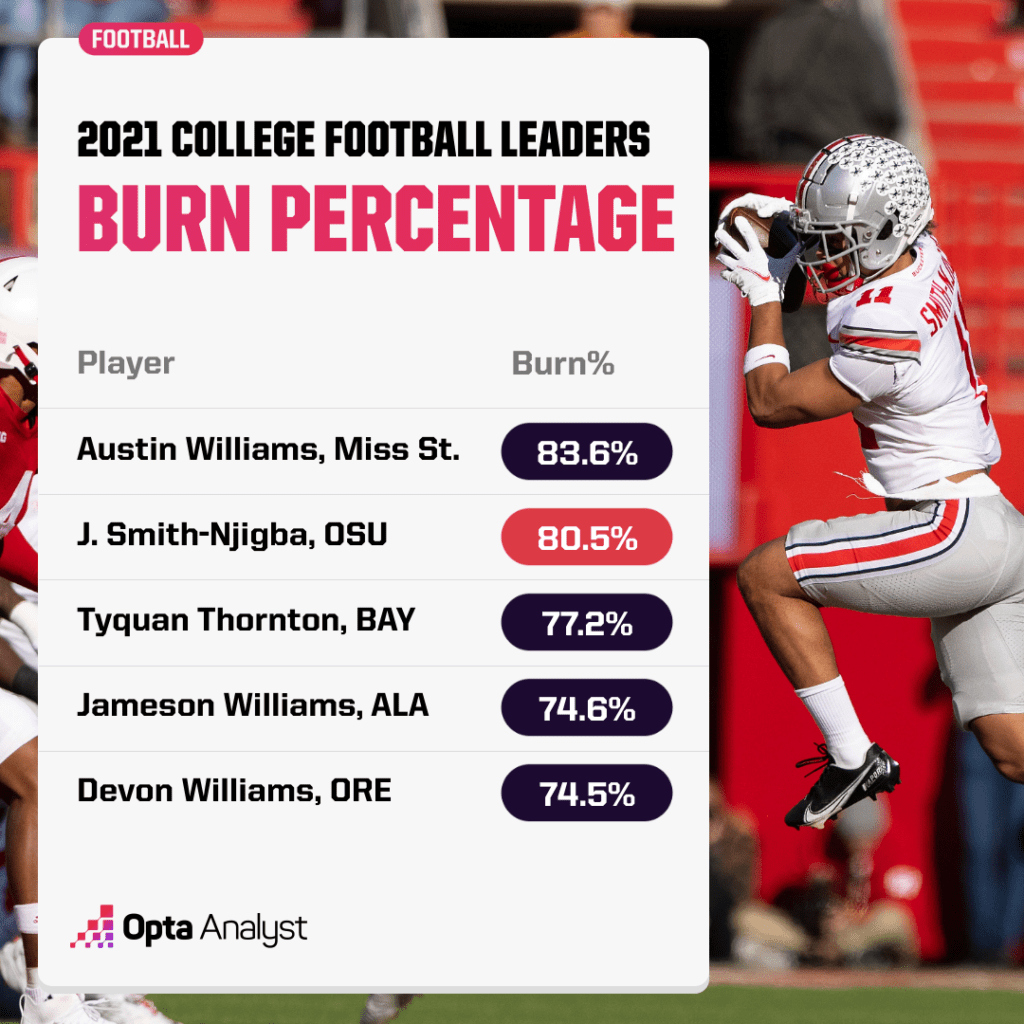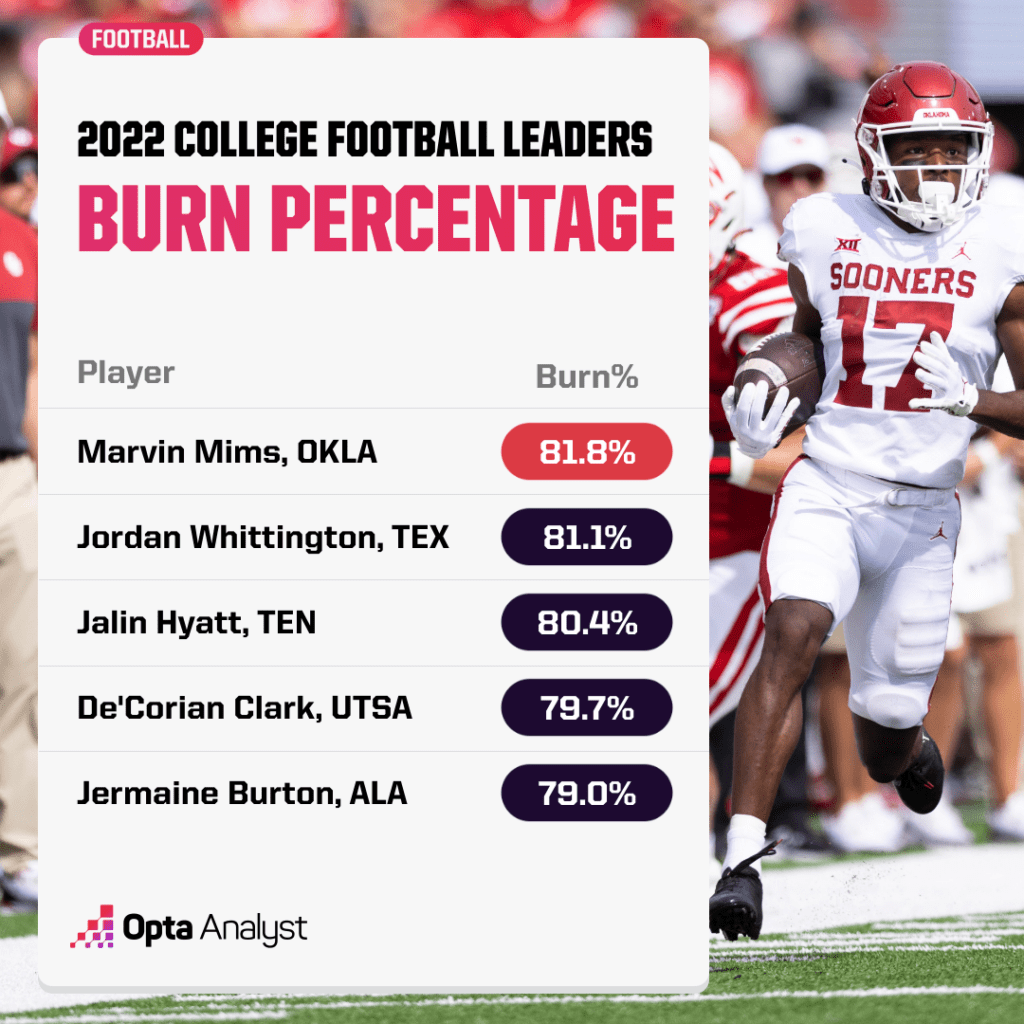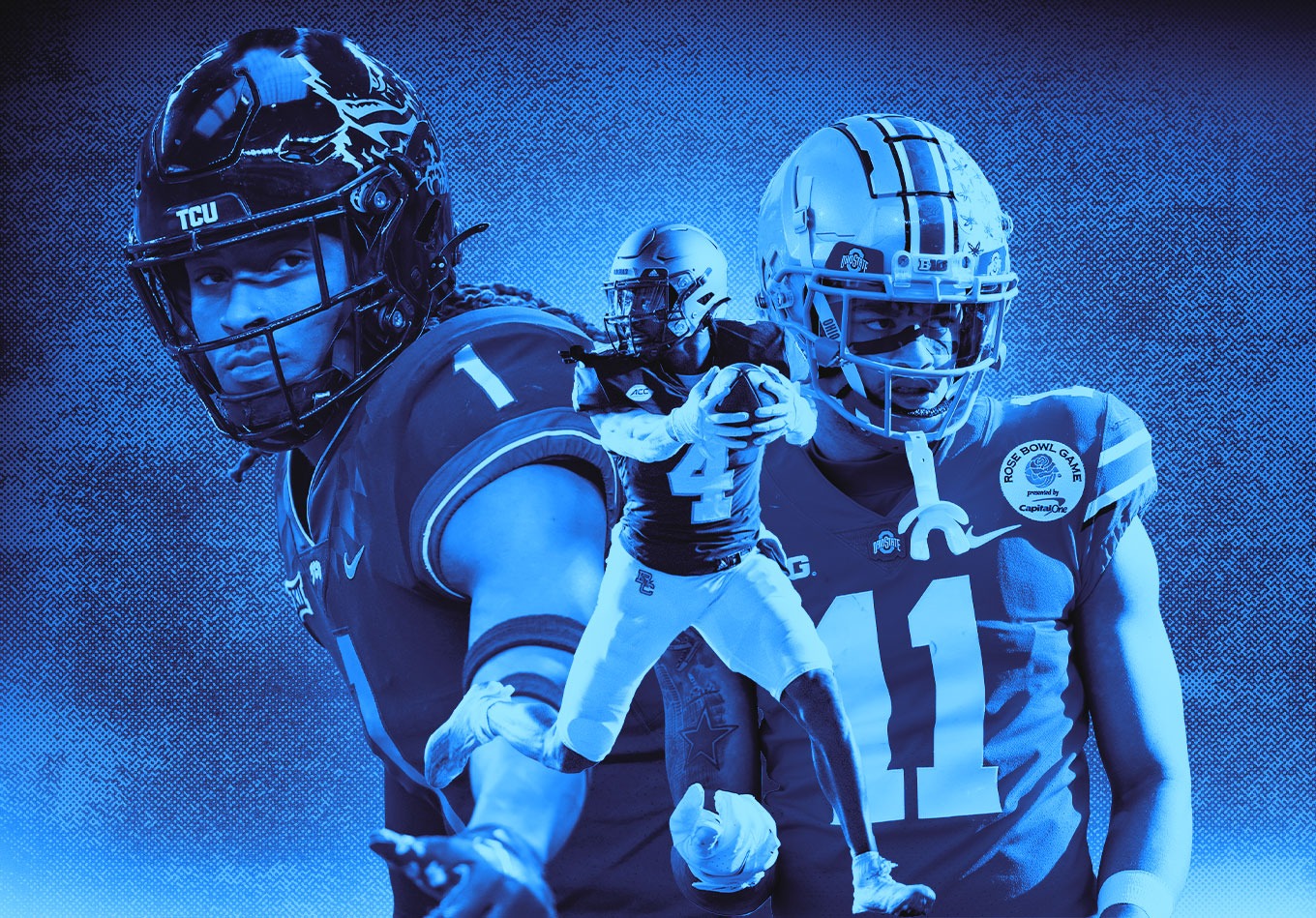Recent NFL Draft history has, in part, been defined by the seemingly endless production line of top-tier prospects at the wide receiver position coming from the college game.
There were six wide receiver prospects taken in the first round of what was considered a historic class in 2020, with Justin Jefferson emerging as a superstar and CeeDee Lamb and Brandon Aiyuk blossoming into high-level starters.
The number of first-round draft picks dropped to five in 2021, including three in the top 10. Ja’Marr Chase, Jaylen Waddle and DeVonta Smith have lived up to their lofty draft statuses with star-level play in the NFL. Smith helped the Philadelphia Eagles reach the Super Bowl LVII last season and was on the losing end of a thriller. The Kansas City Chiefs took a fourth-quarter lead on a touchdown from Patrick Mahomes to Kadarius Toney — the 20th overall pick of that draft by the New York Giants.
There were six first-round wideouts again in 2022, and several stepped up as rookies. Garrett Wilson was the NFL’s Offensive Rookie of the Year for the New York Jets, Chris Olave topped 1,000 yards for a mediocre New Orleans Saints team and Jahan Dotson established himself as a tremendous complement for Terry McLaurin with the Washington Commanders.
Doubts over the receiver class in each of the past three drafts were few and far between in scouting reports. This year, however, the crop of playmakers may not be draft prospects of the same caliber and concerns surrounding the receivers in the mix to be taken early are much more plentiful.
So let’s look at the most pertinent questions surrounding this receiver class ahead of a draft that bucks the trend at a position teams have been increasingly aggressive in addressing in the offseason.
The JSN Dilemma
Jaxon Smith-Njigba played only 59 snaps in 2022 due to injury, yet the most significant issue surrounding the Ohio State star does not concern his durability. It has more to do with how he was used during his career with the Buckeyes.
Smith-Njigba spent 544 of his 623 snaps in the slot in the 2021 campaign and is considered by many to be a ‘slot only’ receiver. But should that prohibit him from being the first receiver taken?
The numbers from his 2021 season would suggest the answer should be an emphatic no. Smith-Njigba was second in college football with an 80.5% burn rate and 11th with 15.9 burn yards per target.

His excellent performance across the board in terms of his ability to create and maximize separation is a result of his smooth and fluid route running. He boasts excellent lower-body flexibility that allows him sell fakes consistently, combining footwork with head fakes and intelligent hand usage to put distance between himself and his defender.
On top of that, he showcases strong awareness when running his routes, which he will alter on the fly to increase separation and facilitate easier completions for his quarterback.
A superb ball-tracker who waits until the last possible moment to bring his hands up, limiting the opportunities for defenders to disrupt at the catch point, Smith-Njigba has outstanding body control and regularly makes catches outside of his frame.
Speed, or lack thereof, is the primary knock on Smith-Njigba outside of his limited time spent as an outside receiver, but it has not prevented him from thriving after the catch. He has the elusiveness to string cuts together and the balance to slip through tackles, with those qualities helping him take short receptions the distance for the Buckeyes.
Smith-Njigba may well continue to be pigeon-holed in the NFL, but he’d be pigeon-holed into a position that is essentially a starting role that carries increasing importance in today’s game.
It’s open for debate whether Smith-Njigba can do the kind of damage the likes of Jefferson and Cooper Kupp have done when lined up in the slot, but the reliability and upside he has already demonstrated from that position is more than enough to make him worthy of a premium pick.
However, it may be difficult to be so definitive about some of the other receivers facing questions about how they will be used in the pros.
Quentin Johnston, WR1?
There are plenty of differing opinions as to which receiver from his class deserves to be the first off the board, and TCU’s Quentin Johnston is among the top options at the position.
However, Johnston’s 1,000-yard season in 2022 was his first truly impressive season, raising the question of whether he is at all worthy of the WR1 tag.
There are a host of arguments in his favor. He has excellent size at a little over 6-foot-2 and 208 pounds, boasts long arms and a sizeable catch radius, and pairs his physical gifts with route running that allows him to win early and late.
Johnston can create leverage with his release and often pairs intelligent footwork with similarly astute hand usage to enable him to defeat press-man coverage.
He can create separation at the top of his route when working back towards the football, with his seemingly effortless body control helping him create yardage after the catch on such routes by consistently making the first man miss while completing the reception. Johnston was fifth in the FBS in missed/broken tackles per touch among wide receivers (min. 60 targets) with 0.38.
Half of Johnston’s problem is completing the process of the catch. For a receiver with his wingspan and ball-tracking ability, he is a maddeningly inconsistent catcher who will let the ball into his body too often and committed seven drops in 2022.
A lack of top-end speed attributed to a burn rate of 60.6% that was below the average of 62.7, but only nine receivers did a better job of creating more separation on a per-target basis. Johnston averaged 14.7 burn yards per target – 21st in the FBS.
Johnston checks most of the boxes for a starting NFL receiver, yet there are wideouts in the class who arguably possess more complete games but come with questions about their physical makeup and their role at the next level.
Does Size Matter?
This wide receiver class may not have the star quality of recent years, but what it does have is an abundance of smaller wideouts who managed to thrive at the college level.
While such success is admirable, it does not always translate to the NFL because pro defenders are far more likely to disrupt such receivers with physical press-man coverage.
The more diminutive receivers have to either have the tools to defeat such coverage or land in an offense that excels at putting pass catchers in space.
With so many of those players in this year’s class, teams around the league will have had internal discussions to gauge organizational belief about the ability of the draft’s plethora of smaller wideouts to make the grade in the pros.
The test case for how the NFL feels about the receivers with those physical profiles may well be Boston College’s Zay Flowers, who measured in at a little over 5-foot-9 and 182 pounds. Flowers is coming off a hugely productive season in 2022, racking up 1,077 receiving yards and 12 touchdowns while lining up on the outside and in the slot.
An impressive route runner with fluid change of direction skills and explosiveness out of his breaks, Flowers displays an acute understanding of how to attack a defender’s leverage. He’s not a burner, but has enough speed to maintain downfield separation when he gets a step on a defender.
Flowers tracks the ball extremely well and excels at adjusting to inaccurate throws. Even at his size, he has shown some ability to win contested-catch battles with opposing corners.
Where Flowers does most of his damage is with the ball in his hands. He is excellent after the catch and can make an impact out of the backfield thanks to his elusiveness and second gear.
Flowers’ performance in burn rate (63%) — which put him just above the average of 62 — is reflective of that a strong route-runner, but perhaps not of an elite separator. He was also on the right side of the ledger in burn yards per target (12.8).
Yet even with those numbers, questions remain over whether he can deliver the same level of performance as an outside receiver at the highest level. If NFL teams view him as a slot only, it’s tough at his size to see Flowers as the first-round pick many expect him to be, especially when there are several players of similar stature with substantially better numbers.
The debate around USC’s Jordan Addison in draft rooms will be markedly similar to that surrounding Flowers. The transfer from Pitt consistently demonstrated elite route-running craft, though he did so while playing at a startlingly 173 pounds.
Addison is extremely smooth when it comes to changing direction, explosive out of his breaks, and can get open by varying his route speeds. He has little problem maintaining the separation he creates, matching Flowers in burn yards per target (12.8) and beating him in burn rate (64.6%).
Yet even with a remarkably refined skill set that includes the ability to make tough catches outside of his frame, there will be teams that won’t be able to justify taking a receiver of his size in the first round.
Oklahoma’s Marvin Mims led all receivers in burn rate (81.8%) and burn yards per target (21.1), illustrating his status as one of the premier deep threats in the class. However, his limited route tree and a lack of reps against press-man coverage should give teams pause.

There are similar concerns about Biletnikoff Award winner Jalin Hyatt of Tennessee (6-foot, 176 pounds), who was fourth in burn rate (80.4%) while playing in Josh Heupel’s pace-and-space spread offense, and Michigan State’s Jayden Reed (5-11, 187) and North Carolina’s Josh Downs (5-9, 171).
Fast, extremely smooth and with the explosiveness in his legs to elevate for the ball and attack it at its highest point, Cincinnati’s Tyler Scott is an undersized receiver who has plenty of fans. He posted a burn rate of 78.4% that put him eighth among all receivers in a 2022 season in which he played the majority of his snaps on the outside.
Because this is a league with coordinators who can put receivers in space, concerns about these smaller receivers could dissipate in time. However, there is a distinct possibility that front offices may pass them over and invest in the few receivers who appear to have both the build and the skill set to quickly make the leap.
Second-Day Finds
A receiver who figures to be one of the first off the board on Day 2 comes from a somewhat unexpected source. That’s because it’s difficult to evaluate the Wake Forest offense because it’s heavily built around a slow-mesh RPO that can be both extremely effective and painful to watch.
But A.T. Perry, one of the team’s top wide receivers in each of the last two seasons, looks to have all the ingredients of starting X receiver at the highest level. His 2,389 receiving yards and 26 touchdowns over the last two seasons both rank third among all FBS receivers in that span.
At 6-foot-3 and 198 pounds, Perry offers an enticing size and speed combination and boasts a variety of tools to help him create separation. He has surprisingly fluidity when changing direction and has the stop-start quickness to defeat coverage by varying his route speeds.
Perhaps most notably, Perry frequently capitalizes on his size advantage to defeat press-man coverage. His hand usage and smooth, long-striding acceleration make him a consistent threat to take it the distance when he gets a step on defenders downfield. That success in getting and staying open is illustrated by his 71.5% burn rate.
Perry’s height gives him a natural advantage in elevating for the ball at the catch point and he gains extra yardage by fighting through tackles and fending defenders off with a stiff arm when he gets the ball in his hands in the open field.
The change of direction fluidity he often displays as a route runner does not translate after the catch. Elusiveness is not a defining feature of Perry’s game, but the same cannot be said of an Ole Miss receiver whose reputation appears to have steadily risen through the pre-draft process.
Jonathan Mingo has gone from sleeper to seeing his name in the first round of some prominent NFL mock drafts, and he could bring tremendous value if he isn’t selected until Friday. He averaged 14.6 burn yards per target in his final season with the Rebels. He also racked up 16.9 yards per reception – eighth among FBS receivers with at least 50 catches in 2022.
Like Mims and Hyatt, Mingo’s production was in part a product of operating in a spread offense that schemed him into space. The difference is that Mingo displayed speed, route-running acumen and home-run hitting ability as a deep threat while playing at a little over 6-foot-1 and 220 pounds.
Despite his size, Mingo has had trouble defeating physical coverage, but he excels at using his release to open the hips of corners and create leverage and can change direction at full speed when working over the middle of the field. Mingo, who is extremely explosive when breaking upfield, can use the agility in his lower half to beat defenders with double moves and will alter the speed of his routes to adjust to the flight of the ball.
Mingo also brilliantly blends elusiveness and contact balance with his speed to rip off substantial yardage after the catch, making him a scoring threat on almost every play.
The cherry on top is Mingo’s versatility. He played 525 snaps as an outside receiver, 241 in the slot and 126 aligned as a tight end, often operating as a de-facto H-back as Ole Miss made use of his physical and determined approach to blocking.
Mingo can win from an array of alignments and in a range of fashions. In a league in which multiplicity has never been more prized, his skill set deserves to be considered worthy of more than a Day-2 pick. However, some mock drafts have him projected to go after receivers like Houston’s Nathaniel Dell, Stanford’s Michael Wilson and SMU’s Rashee Rice.
This is a receiver draft in which many teams will be forced to choose between size and explosiveness at receiver. The franchise that makes the move to snag a wideout who undeniably has an enticing mixture of both could look very smart down the road.
Enjoy this? Follow us on Twitter.
